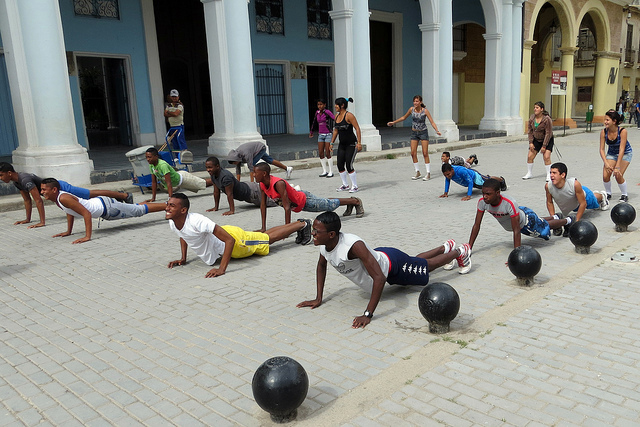
29 Aug Benefits of Physical Education in School
Have you ever had one of those days where you did nothing? I mean, nothing. Sure, you might have caught up on every television show in the western hemisphere, but you went no where, you accomplished nothing, and your movements were limited to the remote control or breaks to grab something out of the kitchen. How did you feel at the end of a day like that? Refreshed? Invigorated? Highly unlikely. We usually feel like we need to take a nap or just settle in for a night’s rest in our bed. This example underscores the importance of physical activity in our regular routine.
Imagine if you did nothing active over a regular period of time. No doubt fatigue, lack of motivation, and other adverse effects would be compounded. It’s important for us to exert ourselves physically. It’s even more important for developing children to be active.
According to letsmove.gov, adolescents 8-18 years of age “spend an average of 7.5 hours a day using entertainment media including TV, computers, video games, cell phones, and movies.” That’s most of the day put toward inactive pursuits. Adolescent years of physical development are among the most important and have a direct bearing on how healthy a person will be as an adult. Doesn’t this stress the importance of school-aged children being properly educated about the benefits of physical activity? Let’s examine some basic activity recommendations and some of the benefits of putting them into practice.
Basic Recommendations
A general recommendation for children is to be physically active at least 60 minutes per day and doing so 5 days per week. Letsmove.gov also offers the alternative tracking method of a pedometer in order to count average daily steps. For girls, they recommend 11,000 steps per day. For boys, they recommend 13,000 steps per day.
Also, it is important to combine physical activity with a routine of healthy eating. PresidentsChallenge.org provides eight ways to eat healthy. They give consideration to fruits, vegetables, whole grains, dairy, water, protein, sodium, seafood, and portion size.
Benefits
Healthy Body
When we are educated on the proper way to do something, we are more motivated (and much more likely) to put it into practice. So, when adolescents are taught proper levels of physical activity, they are more motivated to be active. This, in turn, directly benefits their body.
BENEFITS:
- Controls body weight (i.e. reduces body fat and risk of obesity)
- Reduces risk for disease (i.e. sleep disorders, diabetes, cancer, stroke, heart disease, asthma)
- Improves cardiovascular system
- Improves joint development
- Builds lean muscle
- Builds strong bones
- Improves movement skills
- Improves sleep
- Improves energy
Healthy Mind
“A healthy body equals a healthy mind.” You’ve probably heard that expression before, but it is so true.
BENEFITS:
- Reduces anxiety
- Decreases depression
- Encourages positive mental health
- Reduces irritability
- Decreases impatience
- Improves memory
- Stimulates chemicals of the brain that result in feelings of relaxation and happiness (including feelings that result from doing enjoyable things like hobbies)
- Increases self-esteem and confidence due to better physical shape
Better Grades
According to the CDC, “youth who spend more time in physical education class do not have lower test scores than youth who spend less time in physical education class.” Studies have been conducted that show this to be true. In North Carolina, children from kindergarten to eighth grade were required to be physically active 30 minutes everyday. The number one benefit observed: “improved academic focus.”
BENEFITS:
- Improves ability to stay on-task
- Improves attention span
- Improves memory
- Improves behavior in the classroom
- Better math skills
- Better reading skills
Better Community
Social skills are something that we learn just like anything else in life. So, when children are active together, they gain skills in how best to communicate and deal with one another.
BENEFITS:
- Improves interaction with others (including handling conflict)
- Motivates volunteer spirit in community activities
- Better leadership skills
- Improves character development
- Motivates to put others first
How Schools Can Help
Since adolescents spend so much time at school, there is a lot of opportunity for school systems to support the physical education of their students.
IDEAS:
- Schedule time for students to be physically active
- Classroom lessons that incorporate physical activities (i.e. walk through the woods for science class or act out a story for english class)
- Recess
- Physical education classes
- Break times for physical activity
- Intramural sports before, during, or after school
- Programs for walking or biking to school
- Educate parents about the benefits of physical activity
- Promote physical activity among the school staff so students have role models
- Partner with families and groups in the community
With such an overwhelming list of benefits from physical education and the resulting activity, what school would not want to better incorporate such an initiative into their daily curriculum? If you are a parent, why not share this information with your child’s school? If you’re a staff member at an education-based institution, why not share this information with the rest of the school staff including those who make decisions on the curriculum? When parents, school faculty, and adolescents work together for better physical activity, the results will have ripple effects for a long time to come. This will include less guilt after a day of binge-watching your favorite television series.
——————————————–
Sources:
Photo credit: Alan Kotok / CC 2.0




No Comments